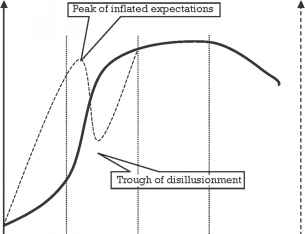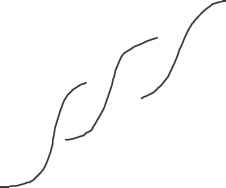The technologies life cycles
Paralleling the concept of product life cycle is the concept of technology life cycle. Any technology will go through different steps, which are important to be understood by strategists and marketers.
The concept of the technology life cycle characterizes the development of technology in a way that is similar to the evolution of organisms. Various forms emerge at the beginning;then the rate of new development declines, extinction sets in, and only a few major alternative forms persist at the end. Once the technology reaches the market, we can correlate the efficiency of its applications and the resources invested in developing its potential (see Figure 2.1).
In the introduction phase, when the company invests heavily, the earnings are slow and not very significant. This is the time when radical technologies are introduced, such as nanotechnology, for example (see Chapter 1 for other examples). It is often a painful process for customers who are experiencing the "bleeding edge" of leading edge technology. Fortunately
Performance Visibility
Performance Visibility

Development Market Growth Maturity Decline introduction
Time/
Development Market Growth Maturity Decline introduction investment
Technology performance curve Technology adoption curve
Figure 2.1 Technology life cycle.
those customers are usually technology specialists who long for this kind of situation, as we will see in detail in Chapter 3.
In the growth phase, the accumulation of knowledge and competence leads to significant earnings. At this stage, one may find a wide range of early experiments with radically different designs aimed at improving the technology.
Very often, the growth phase in performance is not mirrored in the adoption rate by the market. Indeed, the early success of technology tends to create hype and unrealistic expectations. Technology reaches a peak of perception that the Gartner group [10] adequately names the "peak of inflated expectations." This is usually followed by a time of disenchantment, because the new technology's performance does not match the expectations of customers. This was the reason why so many dot-com companies like Webvan, Boo.com, and others, imploded at the beginning of 2000: They were not able to deliver quickly and nicely what they had trumpeted to the world. However, technology keeps improving and once the gap between fad and reality is bridged, the real value of the technology appears to the market.
"Pervasive computing" or "extended Internet" technologies illustrate the point. Today the whole model that a personal refrigerator would dial Web-van and order groceries for the consumer is clearly dead, but pervasive computing applications are taking root slowly in industrial settings, far from the consumer market. Chips, sensors, and wireless and software applications are improving constantly in order to collect and interpret data remotely and instantaneously. Small companies, such as emWare, a software firm, or Ubi-com, a chips manufacturer, as well as large firms, such as IBM or Accenture are working hard on those technologies and consider it as their second chance at the e-commerce revolution. EmWare makes low-cost, easy-to-implement, built-in software that automate the management of new and existing intelligent remote devices, such as industrial controllers in water treatment plants or remote control of home heaters. Ubicom offers low-cost wireless network processors (between $7 to $9) that enable users to connect all kinds of devices from cooling systems to overhead projectors, which can be supervised remotely [11].
As better designs are found, it becomes progressively harder to make further improvements, so variations become more modest, leading to the next phase, the maturity period. This is the time of incremental innovations. During this period, the growing returns undergo a constant improvement of performance (this is now the case for microprocessors in the computer industry or 35-mm film in light-proof canisters in the photography industry). As producers and customers agree on product characteristics, and as the market expands, a transfer might occur from product to process innovation. As an industry becomes more stable, greater confidence is placed on the use of specialized and expensive equipment. This is the case for PCs, where the challenge for firms is to build faster and cheaper and to produce a larger volume of hardware boxes with a limited number of features selected by the customer. American Dell Computer, Taiwanese Acer, and the Chinese
Legend appear to be the champions in mastering the mass manufacturing process required at that stage. In the software industry, Java and XML are two typical examples of mature technologies whose performance is reaching a plateau.
The last phase, a decline or saturation, arises when the physical limits of a technology have been reached, and/or when additional spending and efforts in R&D do not increase penetration or sales, such as in the fixed phone business today for instance.
As seen in Chapter 1, the technology life cycle is similar in phasing to the product life cycle; however, it is different because a product is an output of technology at a given time. This translates to the fact that in each step of a given technology there may be various products with their own life cycles (Figure 2.2). For instance, mainframe technology is at the maturity stage. In 2003 mainframe computers constituted 13% of the computer market, and IDC estimates that they will decline to 8% by 2006, but companies still launch new mainframes, such as the IBM z990, which comes equipped with the latest software available such as WebSphere, Java, and Linux.
More than an absolute physical limit, companies should evaluate a technology's relative limit compared to other technologies. In general, competing technologies are linked together along a growing spiral, which indicates that a new technical procedure requires a higher investment, but with a starting performance much closer to the maximum that it replaces (see Figure 2.3).
This positioning of different technologies is not always easy to carry out. Emerging technologies are often difficult to identify, and performance levels cannot be determined easily because the products still are not well known
Sales
Sales

introduction
Figure 2.2 Technology life cycle and product life cycle.
introduction
Figure 2.2 Technology life cycle and product life cycle.
Technology performance
Technology performance

Man-hours invested
Figure 2.3 Competitive evolution of technologies.
(see Section 2.3.3). On the other side, the competitive pressure of a new technology tends to provoke a vigorous improvement in the old technology. Everyone knows that wooden sailing ships enjoyed a renaissance between 1860 and 1880, shortly after the invention of the iron hulls and compound steam engines that were to supersede them by the beginning of the twentieth century. Similarly, the gas lamp for interior lighting was enhanced tremendously just after the appearance of the incandescent electric light bulb.
More recently, in telecommunications, some improvements often achieved with only minor modifications have produced order-of-magnitude gains that have effectively, postponed the introduction of a new generation of transmission technology. Time-division multiplexing, for instance, now allows a pair of wires to carry 24 voice channels instead of just one;conse-quently, this made fiber optics and cable more expensive and less attractive as a solution for local and low-volume connection.
Similarly, in the 1980s the prospects for communication satellites declined in Europe with the introduction of a new generation of fiber optics, which offered a massive and secure increase in channel capacity at a transmission rate of 500 megabytes per second (versus 50 megabytes per second at the end of the 1970s). However, it is important, for a marketer and for a company, not to believe in the invulnerability of a technology's life expectancy on the supply side.
Continue reading here: The physical and virtual value chain model
Was this article helpful?